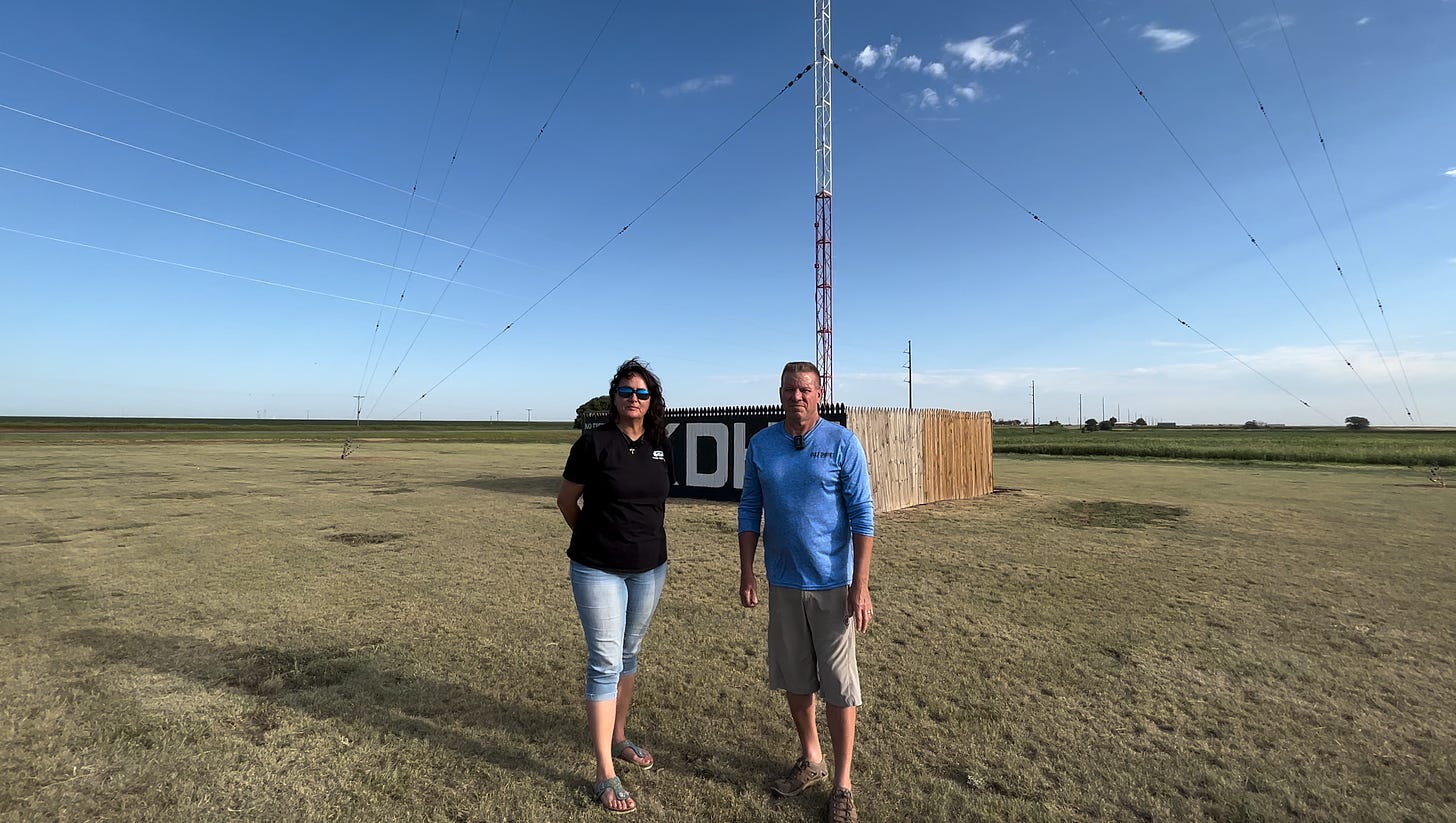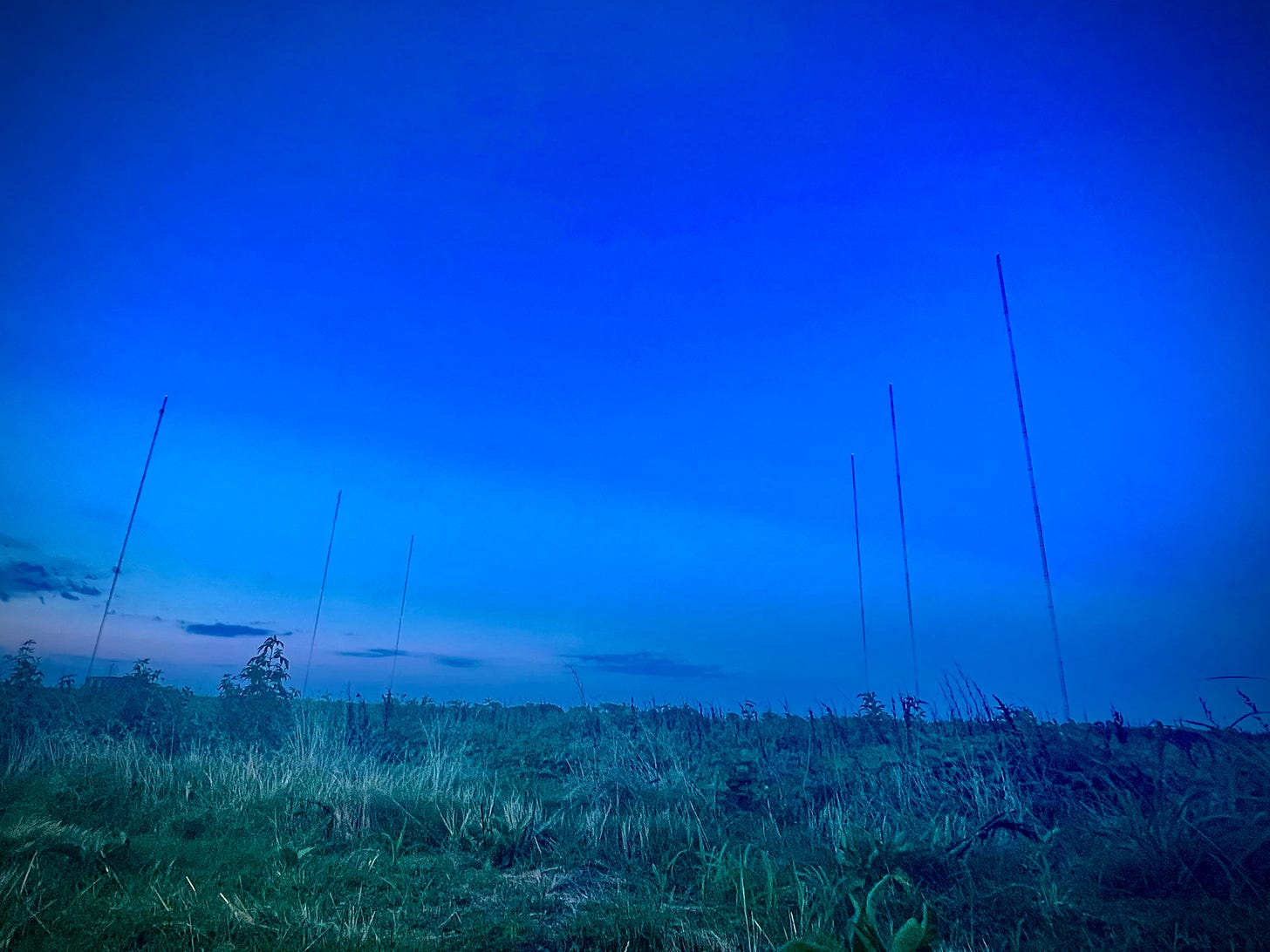AM Radio Fights to Keep Its Spot on Car Dashboards
For rural, ethnic broadcasters in the U.S. the low fidelity band has its advantages
Dimmitt, Texas — The number of AM radio stations in the United States is dwindling. Over the decades, urban and mainstream broadcasters have moved to the FM band, especially music station to take advantage of FM’s superior audio fidelity. Now, there is a new threat to America’s remaining ~4,000 AM stations. Some automakers want to kick AM off their dashboard radios.
In Dimmit, in the state of Texas, that has Nancy and Todd Whalen worried. They are the owners, for the past eight years, of KDHN-AM 1470, on air since 1963. The Whalen are heard live on the station’s morning show and are KDHN’s sole employees.
“We came here to Dimmitt and told people that we wanted to give them something to be proud of. And we feel like what we’ve done and what we continue to do is provide that, not just for Dimmitt but for all the small towns in the area that no longer have local radio stations,” says Nancy Whalen.
KDHN, known as ‘The Twister,’ also has received a Federal Communications Commission license for an FM (frequency modulation) translator, limited to 250 watts, which simulcasts the AM (amplitude modulation) signal. But the 500-watt AM signal covers more territory, about a 160-kilometer radius compared to the 30-kilometer reach of the FM signal.
“The AM radio station is everything for us. We just turned on the FM translator, it'll be two years in September. But the AM signal has been our bread and butter since the beginning,” says Nancy Whalen.
Some urban station owners have decided it is more profitable to sell the real estate on which their antenna towers sit rather than continue to try to make money from commercials targeting a dwindling audience. That is what happened to KDWN in Las Vegas, Nevada, which was authorized by the FCC to transmit the maximum 50,000 watts allowed for AM stations. Corporate owner Audacy sold its 15-hectare transmission site on desert land last year to a real estate developer for $40 million and then switched off the powerful AM station, which had listeners across the entire Western U.S. at night.
Unlike FM band stations, which physics limit to line-of-sight reception, the lower frequency AM signals bounce off the ionosphere after sunset, giving them a range of hundreds – and sometimes thousands -- of kilometers. FM stations have a greater audio frequency range, as they are allowed a wider bandwidth compared to AM stations. The most popular formats for the remaining AM stations in the United States are news/talk programming and sports, followed by country music.
Todd Whalen says audio quality is not an issue for his KDHN listeners.
“Our AM signal actually sounds as good as an FM signal because we have a state-of-the-art transmitter and processing,” he explains.
Recently, some major auto manufacturers announced plans to stop including AM radios in new vehicles, contending electric vehicle motor systems cause interference to reception, making station unlistenable and thus, the AM band obsolete. Broadcasters and lawmakers objected.
U.S. Senator Amy Klobuchar, a Minnesota Democrat, posted a video to Twitter about legislation she co-sponsored that would require vehicle manufacturers to include AM receivers in all new vehicles.
The Senate’s commerce, science and transportation committee approved via voice vote on Thursday the ‘AM For Every Vehicle Act,’ sending it to the Senate floor for consideration.
“Maybe people don’t understand how rural works, but a lot of people drive long distances to get to their town, to visit their friends,” said Klobuchar in her online video. She added she did not think auto manufacturers “understand how important AM radio is to people today.”
People like Rodney Hunter, who manages two grain silo sites in Tulia and Edmonson, Texas. He says news on AM radio about corn, cotton, wheat and cattle are critical.
“I’ve had at least three farmers that called in today and said they heard on the radio that the markets are up. And without AM radio that would not be possible,” he told VOA on a recent morning at the grain silo in Tulia when a halt to grain shipments from Ukraine was causing a surge in the prices of some agricultural commodities.
“Farmers are in their pickups or in their tractors, and they're going up and down the road,” Hunter said. AM radio reception in vehicles “is just a lot handier” than trying to get crop-related news online.
A five-hour drive southeast of Tulia finds Joann Whang, in Carrollton, tuned in to another AM station. She’s not a farmer, but a pharmacist – listening to Korean-language KKDA AM 730.
“My friend told me about it,” she recalls. “At first I thought a Korean radio station is usually for the older generation, but it was actually pretty interesting. You can get all the information and highlights and even Kpop (music).”
The station is owned by the DK Media Group, which also publishes two Korean language weekly newspapers in the Dallas-Ft. Worth area. The company’s president, Stephanie Min Kim, says no AM radios in new cars would imperil ethnic broadcasters who cannot afford the limited and more lucrative FM licenses.
“We feel that it is our duty to help and support our Korean immigrants integrate into American society,” says Kim, a former broadcaster at KBS in South Korea. “So, we invite experts from the law, healthcare and education to provide practical and useful information” over the station’s airwaves.
“More than 40 percent of radio listening is done in the car. So, I think AM radio is facing a potential existential threat,” says Kim.
That existential threat also affects another Dallas-area station – KHSE at 700 on the AM dial.
The station, known as Radio Caravan, with announcers speaking in Hindi, Tamil, English and other languages, plays South Asian music and provides information about community events.
While Radio Caravan also simulcasts on FM from a site some 50 kilometers north of Dallas, that transmission does not have the reach of the 1,500-watt AM station whose transmitter and antenna array are located at a different site, also about 50 kilometers northeast of downtown Dallas.
“I don’t think AM can ever go away,” says Radio Caravan program host Aparna Ragnan, who suggests auto manufacturers find a way to minimize the noise interference in electric vehicles instead of stopping installation of AM receivers in new cars and trucks.
The inferior audio range of AM is not really an issue contends Radio Caravan’s station manager, Vaibhav Sheth.
“It’s the content that matters,” according to Sheth, who also notes that AM stations are a critical link for the alerts sent by the nationwide Emergency Alert System.
“Those sirens go off and your regular programming is interrupted and when there’s an emergency, whether it’s a tornado warning, whether it’s a child abduction, whatever it is that’s happening, it goes to the AM frequency,” he says.
Some radio stations, including those struggling with personnel costs to fill 24 hours of programming, are beginning to use artificial intelligence, known as AI, which can grab real-time information, such as weather forecasts and sports scores, and use cloned voice of announcers to make the computer-generated content sound live.
Kim at DK Media Group says AI may be valuable for some content, such as commercials, but she does not see it replacing empathetic voices interacting with the community in live programming.
“We are human beings,” Kim says.
The Whalens at KDHN in Dimmitt says they have not considered AI even though they could use extra help at their “mon n’ pop’ style station, which also broadcasts some games of the sports teams of the local high school.
“We like being live in the studio. There's just a different energy and a different feel,” says Nancy Whalen. “I think people listening can tell that over the radio. Artificial Intelligence is just that and it's not going to give the listener what they're really looking for.”
Her husband, Todd Whalen, agrees. “We don’t want to be a canned radio station, because there's a lot of canned stations out there.”





